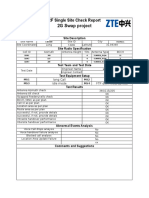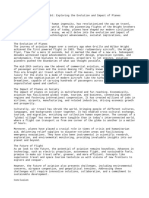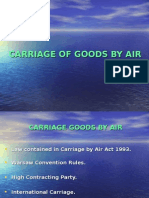Kneeboard - JYO DC SFRA Checklist
Kneeboard - JYO DC SFRA Checklist
Uploaded by
sadh94Copyright:
Available Formats
Kneeboard - JYO DC SFRA Checklist
Kneeboard - JYO DC SFRA Checklist
Uploaded by
sadh94Original Title
Copyright
Available Formats
Share this document
Did you find this document useful?
Is this content inappropriate?
Copyright:
Available Formats
Kneeboard - JYO DC SFRA Checklist
Kneeboard - JYO DC SFRA Checklist
Uploaded by
sadh94Copyright:
Available Formats
Washington DC SFRA
Leesburg (JYO) Procedures
AML R- 004
Basic requirements for DC SFRA Operations / Leesburg
1. Two-way radio
DC Flight
Restricted
Zone (FRZ) 2. Operating transponder w/ altitude
reporting (Mode C)
3. Flight plan appropriate to intended
operation:
IFR: IFR flight plan
VFR: DC SFRA flight plan for pattern
or
practice IFR approaches
4. Transponder code appropriate to in-
tended operation:
Frequencies subject to change.
ALWAYS check NOTAMS! Leesburg egress/ingress (1226) (flight plan not required)
Leesburg pattern work (obtain discrete code)
Area Name Nearest major airport) Telephone
Leesburg practice approaches (obtain discrete code)
Shenandoah Dulles (IAD)
1-866-709-4993 5. VFR speed restriction (≤ 180 KIAS in DC SFRA)
1-540-349-4097
6. Communication:
Reagan National (DCA) 1-866-599-3874
Mount Vernon 1-540-349-0493
Andrews AFB (ADW)
Leesburg ingress/egress: make CTAF calls
Chesapeake Baltimore (BWI)
1-866-429-5882 Leesburg pattern work: CTAF calls & monitor guard if able
1-540-349-8478
Leesburg practice approaches: make request to ATC
Richmond (RIC) 1-866-640-4124
James River 1-540-349-9697
Charlottesville (CHO)
A DC SFRA flight plan is not required for JYO ingress or JYO
ATC Terms Specific to the DC SFRA: egress. Squawk 1226 for both JYO ingress and JYO egress.
Security services: Identification, communications and security tracking provid- Activating DC SFRA Flight Plan for All Other JYO Operations
ed by an ATC facility in support of DOD, or other security elements. NOTE: Traffic pattern: activated with CTAF calls
Security services do not include basic radar services or any other ATC services.
Practice approaches: activated when ATC issues discrete code
Transponder observed: Used in security airspace to inform a pilot that the
assigned beacon code / position have been observed. This transmission does Closing DC SFRA Flight Plan for All Other JYO Operations
not imply ATC services. It conveys only that the transponder reply has been Traffic pattern: close by calling ATC at 540-351-6129
observed and its position correlated for movement through security airspace.
Practice approaches: closes automatically on completion/landing
Remain on the code until you land: Used when Potomac hands an inbound
VFR flight off to the tower or authorizes change to advisory frequency for non- *JYO traffic pattern operations, practice approaches, or transit must obtain a dis-
towered airports. This term reminds pilots to remain on the assigned discrete crete transponder code. Use 1226 ONLY for direct entry/exit at JYO.
transponder code until after landing. NEVER squawk 1200 in the DC SFRA.
*Also see online DC SFRA course at www.faasafety.gov
reviewed 200115 4 1
reviewed 200115
VFR Departure from JYO Pattern Work at JYO
Step 1: Preflight—Check NOTAMs for Current Info Step 1: Preflight—File a DC SFRA Flight Plan
Pilots departing Leesburg VFR using the 1226 squawk are not ALWAYS review NOTAMs for current TFR information.
required to file a DC SFRA flight plan. File DC SFRA flight plan
If desired, file a standard VFR flight plan (search-and-rescue).
Step 2: Pre-Takeoff — Squawk and Talk Step 2: Pre-Takeoff — Activate DC SFRA Flight Plan
Set 1226 code for JYO departure & verify Mode C (ALT) is on. Contact Potomac to obtain discrete transponder code.
Announce make/model, call sign, & intended runway on CTAF. Set assigned code & verify that Mode C (ALT) is on.
Announce make/model, call sign, & intended runway on CTAF.
Step 3: After Takeoff—Depart via Direct Route
Depart DC SFRA via direct route through maneuvering area. Step 3: After Takeoff— Remain in JYO Pattern
Monitor Guard on 121.5 if able.
Remain outside of Class B unless explicitly cleared to enter.
Remain in JYO traffic pattern, and remain outside Class B.
Make pattern position calls on CTAF & monitor 121.5 if able.
Step 4: Exiting—Change Squawk Outside SFRA
Remain on CTAF and squawk 1226 until you are outside the DC Step 4: Landing—Close DC SFRA Flight Plan
SFRA.
Remain on assigned code until pattern work is completed.
Call Potomac TRACON at 540-351-6129 to close the DC SFRA
VFR Arrival at JYO Flight Plan for pattern work at JYO.
Step 1: Preflight—Check NOTAMs for Current Info Practice Instrument Approaches at JYO
Pilots entering Leesburg VFR using the 1226 squawk are not
required to file a DC SFRA flight plan.
Step 1: Preflight—File a DC SFRA Flight Plan
Step 2: Before Entry - Squawk and Talk ALWAYS review NOTAMs for current TFR information.
Set 1226 code for JYO entry & verify that Mode C (ALT) is on. File DC SFRA flight plan:
Announce make/model, call sign, & intended runway on CTAF.
“Leesburg traffic, (make/model/call sign), 10 miles west, will Step 2: Before Entry — Squawk and Talk
maneuver for Runway 17 traffic pattern at Leesburg.”
Monitor Guard on 121.5 if able. Contact Potomac to obtain discrete transponder code.
Remain outside Class B unless explicitly cleared to enter. Set assigned code & verify that Mode C (ALT) is on.
Comply with ATC instructions
Step 3: After Entry—Enter via Direct Route
Enter via most direct route; remain in JYO maneuvering area. Step 3: Upon Completion— Keep the Code
Remain outside Class B unless explicitly cleared to enter. Remain on assigned code until after landing and shut down.
Step 4: Arriving—Landing at JYO
Emergency / Abnormal Situations
Remain on CTAF; squawk 1226 until you land and shut down. Transponder failure:
Contact ATC and comply with all instructions.
If unable to contact ATC, exit the DC SFRA by the most direct lateral route.
Go-Arounds: Pilots should not hesitate to go around if safety does not Communications failure:
permit a landing at JYO on the first attempt. If multiple go-arounds are Squawk 7600 and exit SFRA via most direct route
required for safety reasons, contact Potomac on 127.325 to advise of the
situation; then comply with ATC instructions. Or, if closer to departure point than SFRA boundary, return to departure point.
reviewed 200115 2 reviewed 200115 3
You might also like
- Advancement Exam Study GuideDocument45 pagesAdvancement Exam Study GuideDrizzy RayNo ratings yet
- Preguntas Examen - Licencia Básica de PTLDocument33 pagesPreguntas Examen - Licencia Básica de PTLGustavo Avila Rodriguez0% (1)
- ICAO-FAA Difference in PhraseologyDocument4 pagesICAO-FAA Difference in PhraseologySachin Jain100% (1)
- The Story of Qatar Airways - EnglishDocument5 pagesThe Story of Qatar Airways - Englishswedenborgeano123No ratings yet
- Arsr-4 (FPS-130)Document7 pagesArsr-4 (FPS-130)The Angry ManNo ratings yet
- LTBS/DLM: Mugla, TurkeyDocument50 pagesLTBS/DLM: Mugla, TurkeyTweed3ANo ratings yet
- Print E - AWBDocument1 pagePrint E - AWBvijilrenixNo ratings yet
- Kneeboard - DC SFRA ChecklistDocument2 pagesKneeboard - DC SFRA ChecklistcattuscraniumNo ratings yet
- Airway 5Document101 pagesAirway 5SinazoNo ratings yet
- Instrument Procedures Knocking The Rust OffDocument67 pagesInstrument Procedures Knocking The Rust Offjv7jfc2qwnNo ratings yet
- Takeoff Minimums, (Obstacle) Departure Procedures, and Diverse Vector Area (Radar Vectors)Document5 pagesTakeoff Minimums, (Obstacle) Departure Procedures, and Diverse Vector Area (Radar Vectors)Ty CrisosNo ratings yet
- Table of DC SFRA RequirementsDocument1 pageTable of DC SFRA RequirementsMichael ThelenNo ratings yet
- Ncat Ir Radio Telephony and Short HandDocument4 pagesNcat Ir Radio Telephony and Short HandDumo CharlesNo ratings yet
- LTE SCFT VoLTE REPORT MC2638 FDD Bharti NokiaDocument118 pagesLTE SCFT VoLTE REPORT MC2638 FDD Bharti NokiaGaurav SinghNo ratings yet
- Crew Guidance GPS Spoofing Workgroup 1725297759Document17 pagesCrew Guidance GPS Spoofing Workgroup 1725297759kerujNo ratings yet
- A 330 Approach Briefing/Flows Guide - : W Weather - Obtain ATIS Automation FlowsDocument22 pagesA 330 Approach Briefing/Flows Guide - : W Weather - Obtain ATIS Automation FlowsDeniz Arlıer100% (1)
- 5AEX-AeroStar-A320-Initial-Flight Lesson #1 Rev 6 (07.01.201Document7 pages5AEX-AeroStar-A320-Initial-Flight Lesson #1 Rev 6 (07.01.201Jacky MNo ratings yet
- LSZHDocument32 pagesLSZHsantiago aristizabal garciaNo ratings yet
- 2G Swap Project: RF Single Site Check ReportDocument15 pages2G Swap Project: RF Single Site Check ReportabdNo ratings yet
- Single Cell Function Test (SCFT) Site ID: New Site: No. Activity/ProcessDocument66 pagesSingle Cell Function Test (SCFT) Site ID: New Site: No. Activity/ProcessGuru Prasad MishraNo ratings yet
- Sfra Course NotesDocument80 pagesSfra Course Notessadh94No ratings yet
- 15adobl01 Gbas and GlsDocument4 pages15adobl01 Gbas and GlskiemtvNo ratings yet
- Long 1985Document11 pagesLong 1985Đinh Ngọc Việt Tùng100% (1)
- VFR Circuit Procedures at Uncontrolled Aerodromes: CautionDocument2 pagesVFR Circuit Procedures at Uncontrolled Aerodromes: CautionNetko Netkovic100% (2)
- Tp11541e PDFDocument1 pageTp11541e PDFMarkNo ratings yet
- WX Card 012023Document1 pageWX Card 012023Kenneth CzarneckiNo ratings yet
- 1 Company Landing Minima: DPS WaddDocument2 pages1 Company Landing Minima: DPS WaddIndra JayaNo ratings yet
- Departure ProceduresDocument18 pagesDeparture ProceduresChristian AtanacioNo ratings yet
- Egress IP Traffic ShapingDocument9 pagesEgress IP Traffic ShapingMedAliAbdelliNo ratings yet
- Kuliah Pertemuan 13b - RW ConfigurationDocument24 pagesKuliah Pertemuan 13b - RW ConfigurationDio AkhbarNo ratings yet
- A320.Normal Procedures Self Study - lpc.V001.130101Document29 pagesA320.Normal Procedures Self Study - lpc.V001.130101Tony Paco100% (2)
- C525 TR Student Session GuideDocument7 pagesC525 TR Student Session GuideRex FoxNo ratings yet
- b777 Low Visibility ProceduresDocument16 pagesb777 Low Visibility ProceduresHenry DarlingtonNo ratings yet
- 3.01 DP Planning Practice - Procedures Rev CDocument18 pages3.01 DP Planning Practice - Procedures Rev CMukesh RaiNo ratings yet
- Aeronautical Charting Forum Instrument Procedures Group: October 27, 2009Document6 pagesAeronautical Charting Forum Instrument Procedures Group: October 27, 2009sandro5avantaggiatoNo ratings yet
- ATM Contingency Planning For International Flights - Karachi FIR PakistanDocument5 pagesATM Contingency Planning For International Flights - Karachi FIR PakistanSaif Ur Rehman Shahid100% (1)
- In Flight Guide CJ3 Edition 5Document39 pagesIn Flight Guide CJ3 Edition 5AmandoNo ratings yet
- RKSIDocument41 pagesRKSIflorian_pilgerNo ratings yet
- 3G Capacity Optimization - HuaweiDocument39 pages3G Capacity Optimization - HuaweiSandeepNo ratings yet
- LVO - QRH (01 Oct 2013) PDFDocument4 pagesLVO - QRH (01 Oct 2013) PDFPuventhiran Subramaniam100% (1)
- A Fretwell Yang LiuDocument17 pagesA Fretwell Yang LiumazinmaazNo ratings yet
- BSNL KL RP-00515 L700 Final ReportDocument21 pagesBSNL KL RP-00515 L700 Final ReportAGMBSS KLMNo ratings yet
- HMI Theory Exam Review - V2Document4 pagesHMI Theory Exam Review - V2ZanzibarNo ratings yet
- 08.02.18 GRD110 - H1H4CS3.indd: The Data Given in This Catalog Are Subject To Change Without NoticeDocument20 pages08.02.18 GRD110 - H1H4CS3.indd: The Data Given in This Catalog Are Subject To Change Without Noticekrishna mohanNo ratings yet
- Aircraft Navigation SystemDocument19 pagesAircraft Navigation SystemAdrianne Mae Dimalanta100% (3)
- FAA H 8083 16B - Chapter - 1Document128 pagesFAA H 8083 16B - Chapter - 1viv.san1984No ratings yet
- Farnborough ACP Operators Briefing PackDocument9 pagesFarnborough ACP Operators Briefing PackOlegas LesinasNo ratings yet
- Airbus Approach Briefing/Flows Guide: W Weather - Obtain ATIS Automation FlowsDocument23 pagesAirbus Approach Briefing/Flows Guide: W Weather - Obtain ATIS Automation Flowsdisc911No ratings yet
- Airbus Approach Briefing/Flows Guide: W Weather - Obtain ATIS Automation FlowsDocument22 pagesAirbus Approach Briefing/Flows Guide: W Weather - Obtain ATIS Automation FlowsRiccardo MazzaiaNo ratings yet
- Nellis AFB Take-Off Minimums and Obstacle) Departure Procedures SW4TODocument11 pagesNellis AFB Take-Off Minimums and Obstacle) Departure Procedures SW4TOMark VerveldNo ratings yet
- A60 1490 000 001 - KRA405B - Altimeter BroDocument4 pagesA60 1490 000 001 - KRA405B - Altimeter BroJosueFerreiraNo ratings yet
- Sus Takeoff MinimumsDocument32 pagesSus Takeoff MinimumspedatiNo ratings yet
- Milas, Turkey Ltfe/Bjv: 1.1. Atis 1.2. Preferential Rwy System Operations 1. GeneralDocument26 pagesMilas, Turkey Ltfe/Bjv: 1.1. Atis 1.2. Preferential Rwy System Operations 1. GeneralTweed3ANo ratings yet
- Cessna PDocument4 pagesCessna PLovely AquinoNo ratings yet
- Pilot Guide 006 08248 0003 - 3 PDFDocument34 pagesPilot Guide 006 08248 0003 - 3 PDFYuka ImaiNo ratings yet
- VNKTDocument34 pagesVNKTabang fayyadNo ratings yet
- Slide Bài Giảng A D S - B: Khoa Điện Tử Viễn ThôngDocument64 pagesSlide Bài Giảng A D S - B: Khoa Điện Tử Viễn ThôngLê Trung NamNo ratings yet
- Radar ATSDocument29 pagesRadar ATSCaesar videoNo ratings yet
- Overview of SSR and Iff SystemsDocument109 pagesOverview of SSR and Iff SystemsmonaNo ratings yet
- Communication Navigation SysDocument9 pagesCommunication Navigation SysSrushti R KumarNo ratings yet
- Concise Encyclopedia of System Safety: Definition of Terms and ConceptsFrom EverandConcise Encyclopedia of System Safety: Definition of Terms and ConceptsNo ratings yet
- A330 Normal Law: Putting Fly-by-Wire Into PerspectiveFrom EverandA330 Normal Law: Putting Fly-by-Wire Into PerspectiveRating: 5 out of 5 stars5/5 (2)
- All-Digital Frequency Synthesizer in Deep-Submicron CMOSFrom EverandAll-Digital Frequency Synthesizer in Deep-Submicron CMOSNo ratings yet
- Rockwell Collins 6100 FMS Quick Reference GuideDocument21 pagesRockwell Collins 6100 FMS Quick Reference Guidesadh94100% (1)
- GIV Pilot Initial Limitations HandoutDocument2 pagesGIV Pilot Initial Limitations Handoutsadh94No ratings yet
- FS - Learjet 35A 36A Expanded Checklist FC-200 Autopilot 43 Pages PrintedDocument43 pagesFS - Learjet 35A 36A Expanded Checklist FC-200 Autopilot 43 Pages Printedsadh94No ratings yet
- 02 2ezii (Ex LX DX) Codde2Document1,285 pages02 2ezii (Ex LX DX) Codde2sadh94100% (1)
- 02-2EZII Performance CODDE 2 SupplementDocument382 pages02-2EZII Performance CODDE 2 Supplementsadh94100% (1)
- Aerodrome LicenceDocument33 pagesAerodrome LicenceesessinghNo ratings yet
- JT8D-200 TransportabilityDocument8 pagesJT8D-200 TransportabilityJonathan Rosenzweig100% (1)
- Os Erj Legacy Operations ManualDocument26 pagesOs Erj Legacy Operations Manualednaus0% (1)
- 737 Digital Cabin Pressure Control SystemDocument32 pages737 Digital Cabin Pressure Control Systemd xhNo ratings yet
- 071 - Operational Procedures - QuestionsDocument28 pages071 - Operational Procedures - QuestionsEASA ATPL Question BankNo ratings yet
- A Study in Reducing The Cost of Vertical Flight With Electric Propulsion 12293Document1 pageA Study in Reducing The Cost of Vertical Flight With Electric Propulsion 12293Mongoose82No ratings yet
- Aviation LegislationDocument152 pagesAviation LegislationVikesh89% (9)
- Extended TKTDocument1 pageExtended TKTpallabNo ratings yet
- Air Passenger Bill of Rights - 10 December 2012Document2 pagesAir Passenger Bill of Rights - 10 December 2012Anonymous 03JIPKRkNo ratings yet
- HelikoptersDocument2 pagesHelikoptersHrvy AndyntNo ratings yet
- Chapter 9 Applications of TrigonometryDocument9 pagesChapter 9 Applications of Trigonometrymlb_blmNo ratings yet
- The Air Cargo IndustryDocument30 pagesThe Air Cargo IndustryJoao Silva100% (5)
- New Text DocumentDocument2 pagesNew Text DocumentPickle RickNo ratings yet
- Model Questions & Answers - Air CargoDocument8 pagesModel Questions & Answers - Air CargoHari RamaKrishnanNo ratings yet
- Ticket 1680306985 1713632929645Document3 pagesTicket 1680306985 1713632929645Akshay KumkarNo ratings yet
- Dgca CAR M-1 Carriage by Air of Persons With Disability And/ or Persons With Reduced Mobility in IndiaDocument12 pagesDgca CAR M-1 Carriage by Air of Persons With Disability And/ or Persons With Reduced Mobility in IndiaVaishnavi JayakumarNo ratings yet
- Flight Sim 2004 ManualDocument16 pagesFlight Sim 2004 ManualJamesson LimaNo ratings yet
- Current and Emerging Trends in AerospaceDocument16 pagesCurrent and Emerging Trends in AerospaceKarthick. GNo ratings yet
- Air Waybill: Routing and DestinationDocument2 pagesAir Waybill: Routing and DestinationJerod SmithNo ratings yet
- Vacuum Braking SystemDocument20 pagesVacuum Braking SystemYugandhar Yugu100% (1)
- Citycraft: BOEING 737-8K5Document17 pagesCitycraft: BOEING 737-8K5Clyde Soriano100% (2)
- Cases Emirates & Air Arabia Cunanan, K.Document7 pagesCases Emirates & Air Arabia Cunanan, K.Kim Arrianne CunananNo ratings yet
- Helsinki-FINAIR - 105 2449360389Document2 pagesHelsinki-FINAIR - 105 2449360389bankerjudisNo ratings yet
- Carriage by AirDocument7 pagesCarriage by AirHaroonĦammadiNo ratings yet
- Grade 4 EnglishDocument6 pagesGrade 4 EnglishThinaya JayarathneNo ratings yet
- EscalatorDocument10 pagesEscalatorsagrikakhandkaNo ratings yet
- Civil Aviation Authority of The Philippines Aircraft Accident Investigation and Inquiry Board Aircraft Accident ReportDocument2 pagesCivil Aviation Authority of The Philippines Aircraft Accident Investigation and Inquiry Board Aircraft Accident ReportBenedict CarandangNo ratings yet






























































































